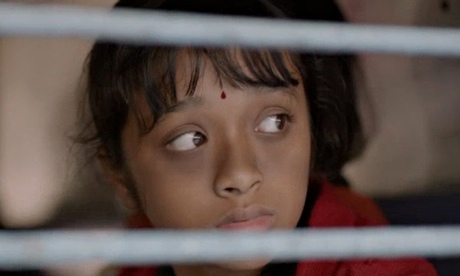
Emma Thompson isn't happy. "12 Years a Slave wins all these awards," she says, "yet slavery is one of the world's fastest-growing industries. The word 'irony' doesn't cover it. We've got to look at it, and we're not managing at all. We're fucked up, really fucked up. What goes on out there beggars belief."
Of the world's 27 million labour and sex slaves, two thirds are in India, Nepal and Pakistan. This painful reality compelled Thompson to executive-produce Sold, which tells the story of Lakshmi, a 13-year-old Nepalese girl who is trafficked into Calcutta's prostitution racket. Niyar Saikia is astonishing as Lakshmi, while Gillian Anderson also stars as a photographer who seeks to rescue her. Sold opens this year's London Indian film festival.
Through her charity work, Thompson has met survivors of trafficking, and is adamant that the film does their experience justice. "It's so human and infinitely watchable," she says. "You see this little girl's character; she's so determined and she understands her situation. She watches the older women who've been brutalised by their experiences and comments on it. It does reflect the stories of these survivors."
Sold is the debut feature of US director Jeffrey Brown, whose stepfather is Indian. "You see everything in India," he says. "You smell jasmine and human faeces at the same time. It bombards your senses and tests your head and your heart. It has the richest stories in the world."
His film, based on a novel by Patricia McCormick, was made with the express intention of spotlighting the tragedy of enslaved children and raising funds for them. "I wanted to make a film that would help real kids," he says. But Thompson is keen to claim it as entertainment as well as agitprop. "Sometimes when life's at its worst, when we're up against the wall, that's when we laugh the most. What Jeff has done is to brilliantly focus on that, so we can recover from our natural horror at this girl's situation."
Much of Brown's previous career was in children's television, and he drew on that experience to show Lakshmi's heroism from her own perspective, through her appalling journey from the Himalayas to the congested squalor of the city. "At the beginning, we shot her from above to make her look small and vulnerable, and as she grows in strength we gradually put her on a par with the adults in the movie. By the end, the camera is looking up at her."
As well as a largely Indian cast, Brown used an Indian crew. But shooting in India brings unique problems. "The most challenging thing isn't the inevitable crowds that converge around you but the sheer noise," says Brown. "We had to do what Bollywood films always do. We spent 26 days recording the sounds again. All the dialogue and all the sound effects – footsteps, cups being put down, everything."
The film is one of a handful on the programme that are the product of the increasing integration of western and Indian talent and finance. Such cross-pollination was present at the start of the movie industry in the subcontinent. Bombay Talkies, India's first studio, established in 1934, was founded on the skill of European technicians, particularly Germans. And in 1935 an American director, Ellis R Dungan, arrived in India intending to stay only six months. Over the next 15 years he laid the foundations of Tamil cinema, working on 14 films without ever knowing the language. His story is told in the documentary An American in Madras, also showing at the festival. As is Hank and Asha, a modern-day tale of Indo-American connection, in which an Indian student falls into an online romance with an American documentarist.
This ever-closer relationship has caught the attention of Disney, whose upcoming Million Dollar Arm stars Jon Hamm as a US sports agent who goes to Lucknow in search of baseball-pitching talent, based on the true story of the first two Indians to play the game professionally in the US. The ambition and striving energy of modern India provides an all-American tale of poor boys making good. One of them is played by Madhur Mittal – best known as the gangster older brother in Slumdog Millionaire. "It's the story of the underdog," he says. "It's a fish-out-of-water movie. You got this American in India, and then you have these Indian kids in America."
His own experience as an Indian working in Hollywood has been positive. "Before Slumdog, I wasn't sure how I would be treated," he says. "But I've been completely welcomed and been treated with so much warmth."
Hamm reacted to India with similar enthusiasm, Mittal reports. "He's so charming and such a gentleman. Even when it was so hot he needed to change his shirt 20 times, he never complained. I cooked him my mother's dal makhani recipe, because the on-set catering was a bit mild and I wanted him to taste something authentic. He loved it, even though he was in tears because it was so spicy."
• The London Indian film festival runs from 10-17 July.

